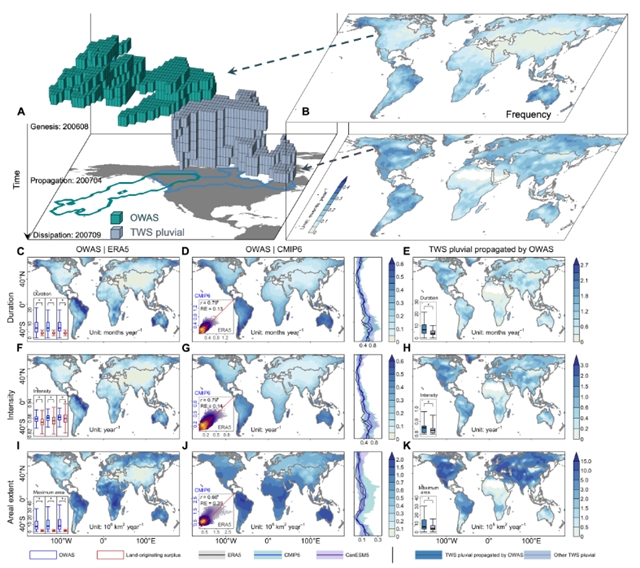
近日,中国地质大学顾西辉团队揭示了气候变化背景下,北部中高纬度地区过剩水资源连续从海洋迁移而来。相关论文于2025年8月15日发表在《科学进展》杂志上。
陆地水资源供应维系着生计、社会经济发展和生态系统。尽管了解了海洋湿度对陆地极端水文气候的贡献,但陆地可用水的过剩主题是否直接和连续地从海洋迁移以及气候变化对这一过程的影响仍不清楚。
研究组提出了一种相干特征跟踪方法来识别海洋到陆地的水可用性剩余主题(OWASs),其特征是大气中过量淡水(降水-最小值-蒸散)从海洋到陆地的时空连续迁移。在过去的几十年里,特别是在北部中高纬度地区(NMHL;在48°N以上),与单纯在陆地上发展的OWAS相比,OWAS持续时间更长、面积范围更广、强度更大。这些向陆地迁移与大西洋的季节性遥相关和太平洋环流的转移有关。在温度变暖情景下,预估这两个过程将被增强,在大气对未来变暖的热力学响应驱动下,NMHL的OWAS特征将显著增加。加剧的OWASs不仅有助于缓解长期干旱,而且有可能加剧暴雨风险。
附:英文原文
Title: Excess water availability in northern mid-high latitudes contiguously migrated from ocean under climate change
Author: Yansong Guan, Xihui Gu, Lunche Wang, Tianjun Zhou, Jun Xia, Dabang Jiang, Louise J. Slater, Luis Gimeno, Yadu Pokhrel, Gabriele Villarini, Jong-Seong Kug, Seok-Woo Son, Richard P. Allan, Jianfeng Li, Thian Yew Gan, Yinxue Liu, Dongdong Kong, Xiang Zhang, Xiangsen Cui
Issue&Volume: 2025-08-15
Abstract: Terrestrial water availability sustains livelihoods, socioeconomic development, and ecosystems. Despite an understanding of contributions of oceanic moisture to terrestrial hydroclimatic extremes, whether surpluses of terrestrial water availability migrate directly and contiguously from the ocean and the influence of climate change on this process remain unclear. Here, we use a coherent feature-tracking method to identify ocean-to-land water availability surpluses (OWASs), characterized by spatiotemporally contiguous migration of excess atmospheric freshwater (precipitation-minus-evapotranspiration) from ocean to land. Over the past several decades, especially in northern mid-high latitudes (NMHL; above 48°N), OWASs have exhibited longer persistence, wider areal extent, and greater intensity than those developed solely over land. These landward migrations are associated with seasonal Atlantic teleconnection and Pacific circulation shift. Under the business-as-usual scenario, these two processes are projected to be enhanced, markedly increasing OWAS characteristics in NMHL driven by thermodynamic atmospheric responses to future warming. Intensified OWASs may not only help alleviate long-term droughts but also have the potential to accentuate pluvial risks.
DOI: adv0282
Source: https://www.science.org/doi/10.1126/sciadv.adv0282
